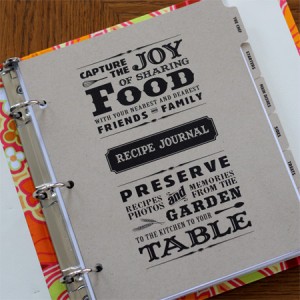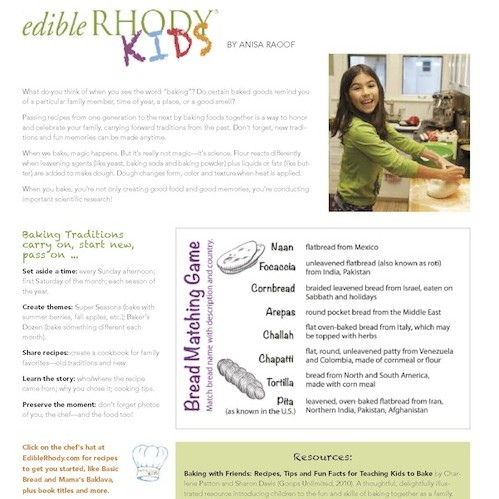 Welcome Winter! Edible Rhody KIDS is created in collaboration with Edible Rhody magazine. Grab this season’s copy of Edible Rhody, available at various locations around Rhode Island. This seasons’ topic, “Baking Traditions”, invites kids to honor and/or create their own family food experiences. I also share one of my favorite holiday recipes handed down from my Iraqi grandmothers – Baklava. Click on the chef’s hat for more theme-related recipe!
Welcome Winter! Edible Rhody KIDS is created in collaboration with Edible Rhody magazine. Grab this season’s copy of Edible Rhody, available at various locations around Rhode Island. This seasons’ topic, “Baking Traditions”, invites kids to honor and/or create their own family food experiences. I also share one of my favorite holiday recipes handed down from my Iraqi grandmothers – Baklava. Click on the chef’s hat for more theme-related recipe!
What do you think of when you see the word “baking”? Do certain baked goods remind you of a particular family member, time of year, a place, or a good smell?
Passing recipes from one generation to the next by baking foods together is a way to honor and celebrate your family, carrying forward traditions from the past. Don’t forget, new traditions and fun memories can be made anytime.
When we bake, magic happens. But it’s really not magic–it’s science. Flour reacts differently when leavening agents (like yeast, baking soda and baking powder) plus liquids or fats (like butter) are added to make dough.

Dough changes form, color and texture when heat is applied. When you bake, you’re not only creating good food and good memories, you’re conducting important scientific research!
Baking Traditions: Carry on, start new, pass on …
Set aside a time: every Sunday afternoon; first Saturday of the month; each season of the year.
Create themes: Super Seasons (bake with summer berries, fall apples, etc.); Baker’s Dozen (bake something different each month).
Share recipes: create a cookbook for family favorites–old traditions and new. Learn the story: who/where the recipe came from; why you chose it; cooking tips. Preserve the moment: don’t forget photos of you, the chef–and the food too!
Play the Bread Matching Game! Match the name of the bread with its description and country of origin.
 Baking with Friends: Recipes, Tips and Fun Facts for Teaching Kids to Bake by Charlene Patton and Sharon Davis (Goops Unlimited, 2010). A thoughtful, delightfully illustrated resource introducing children to the fun and skills of baking together as a family.
Baking with Friends: Recipes, Tips and Fun Facts for Teaching Kids to Bake by Charlene Patton and Sharon Davis (Goops Unlimited, 2010). A thoughtful, delightfully illustrated resource introducing children to the fun and skills of baking together as a family.
Rag and Bone Bindery Recipe Journal. Easy-to-use binder with plastic sleeves for recipe cards. Spots to jot cooking memories and more. Made in Rhode Island!
KingArthurFlour.com has thousands of yummy recipes, tips and even a baking hotline. We want to see what you’re baking! Email your best food photo to info@EdibleRhody.com and we’ll put it on our website.
Mama’s Baklava
Appropriate for:
Ages 4—10, supervised.
Experienced cooks ages 11 and up, unsupervised.

Baklava is a dessert originating in the Middle East made with phyllo dough filled with chopped nuts. Passed down from my Iraqi grandmother, baking baklava has become our family tradition around the holidays. Other Middle Eastern countries have their own variations of spices, nuts and sweeteners. Some recipes include rose water.
You’ll need a large sheet pan with ½-inch sides and a pastry brush for this recipe.
- 1 package phyllo dough, room temperature
- 1 pound walnuts (chopped fine)
- 2 teaspoons sugar
- ½ teaspoon ground cardamom
- ½ pound unsalted butter, melted
- Syrup*
Preheat oven to 350°.
In a large bowl, mix together walnuts, sugar and cardamom. (Using a food processor to lightly pulse ingredients together works too!) Divide walnut mixture evenly among three separate small bowls. Remove phyllo dough from package, carefully unfold and lay on the counter. Cover dough with a sheet of plastic wrap to keep it from drying out while you assemble the baklava.
Using the pastry brush, brush 2 tablespoons melted butter over the bottom of a 9- by 13-inch rimmed sheet pan. Lay 1 sheet of phyllo dough evenly across the pan and brush lightly with melted butter. Repeat 12 times. Spread first portion of walnut mixture evenly across the top.
Repeat layering of phyllo dough brushed with butter for 5—6 more layers of dough. Spread next portion of walnut mixture evenly over dough.
Repeat layering of phyllo dough brushed with butter for more 5—6 layers. Spread last portion of walnut mixture evenly over dough. Repeat layering of phyllo dough brushed with butter for 10—12 last layers of dough.
Have an adult help you cut the baklava evenly into 2-inch diamond shapes by cutting across the pan in two directions. Pour any remaining butter over the top.

Place in the middle rack in the oven and bake for 30 minutes. Raise temperature to 425° to brown the baklava for 10 more minutes. Remove from oven when golden brown.
Pour prepared syrup over cooled baklava. Let rest 20 minutes. Use a spatula to remove diamond pieces and store in a tight container.
*Syrup
- 2 cups sugar
- 1 cup water
- 1 teaspoon lemon juice
- 1 teaspoon cardamom
Place ingredients in a saucepan over high heat. Boil for 10 minutes over medium heat, stirring occasionally. Let cool. Use to pour over cooled baklava.











congrats on another delicious collaboration with edible rhody! i enjoyed everything about this piece especially how it reminds us that every culture connects with something as seemingly simple as bread.
xo
elyse